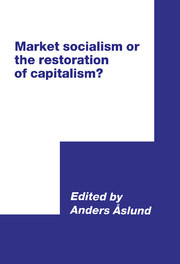Book contents
- Frontmatter
- Contents
- Notes on contributors
- Introduction
- Part I Market socialism revisited
- Part II Economic thinking and policy-making
- Part III Effects of perestroika on Soviet life
- 8 Employment and the reallocation of labour in the USSR
- 9 Changes in income inequality in the USSR
- 10 Estonia's economic development 1940–1990 in comparison with Finland
- Index
- SELECTED PAPERS FROM THE FOURTH WORLD CONGRESS FOR SOVIET AND EAST EUROPEAN STUDIES, HARROGATE, JULY 1990
9 - Changes in income inequality in the USSR
from Part III - Effects of perestroika on Soviet life
Published online by Cambridge University Press: 04 August 2010
- Frontmatter
- Contents
- Notes on contributors
- Introduction
- Part I Market socialism revisited
- Part II Economic thinking and policy-making
- Part III Effects of perestroika on Soviet life
- 8 Employment and the reallocation of labour in the USSR
- 9 Changes in income inequality in the USSR
- 10 Estonia's economic development 1940–1990 in comparison with Finland
- Index
- SELECTED PAPERS FROM THE FOURTH WORLD CONGRESS FOR SOVIET AND EAST EUROPEAN STUDIES, HARROGATE, JULY 1990
Summary
Introduction
This chapter is a part of a long-term project investigating the interrelationship between economic reforms in the Soviet Union and changes in income inequality. It aims specifically to examine how the increasing role played by the market mechanism affects the pattern of income distribution in that country. This chapter, seen as a point of departure for this long-term project, sets out to analyze what the Soviet record is in the field of wage and income distribution during the last two to three decades. Such ‘stock taking’ is not only valuable in itself but is also a necessary first step towards the further investigation of the complex correlation between the marketization of the Soviet economy and changes in the inequality of income.
Statistical data about income distribution in the USSR were for many years a strongly guarded secret. Only occasionally have Soviet economists been allowed to reveal the ‘secret’ and published in the form of a ready statement the relative dispersion of wages and incomes, usually decile ratios, without giving the frequency distribution from where it was computed. According to N.E. Rabkina and N.M. Rimashevskaia, the decile ratios in the socialized sector were as follows:
1964 – 3.69
1966 – 3.26
1968 – 2.83
1972 – 3.10
1976 – 3.35
1981 – 3.00
Western economists, however, have been able, on the basis of the theoretical assumption that Soviet distribution of wages and family incomes are log-normal, to calculate the decile ratios and offer percentiles ratios without frequency distribution data.
- Type
- Chapter
- Information
- Market Socialism or the Restoration of Capitalism? , pp. 172 - 193Publisher: Cambridge University PressPrint publication year: 1991



